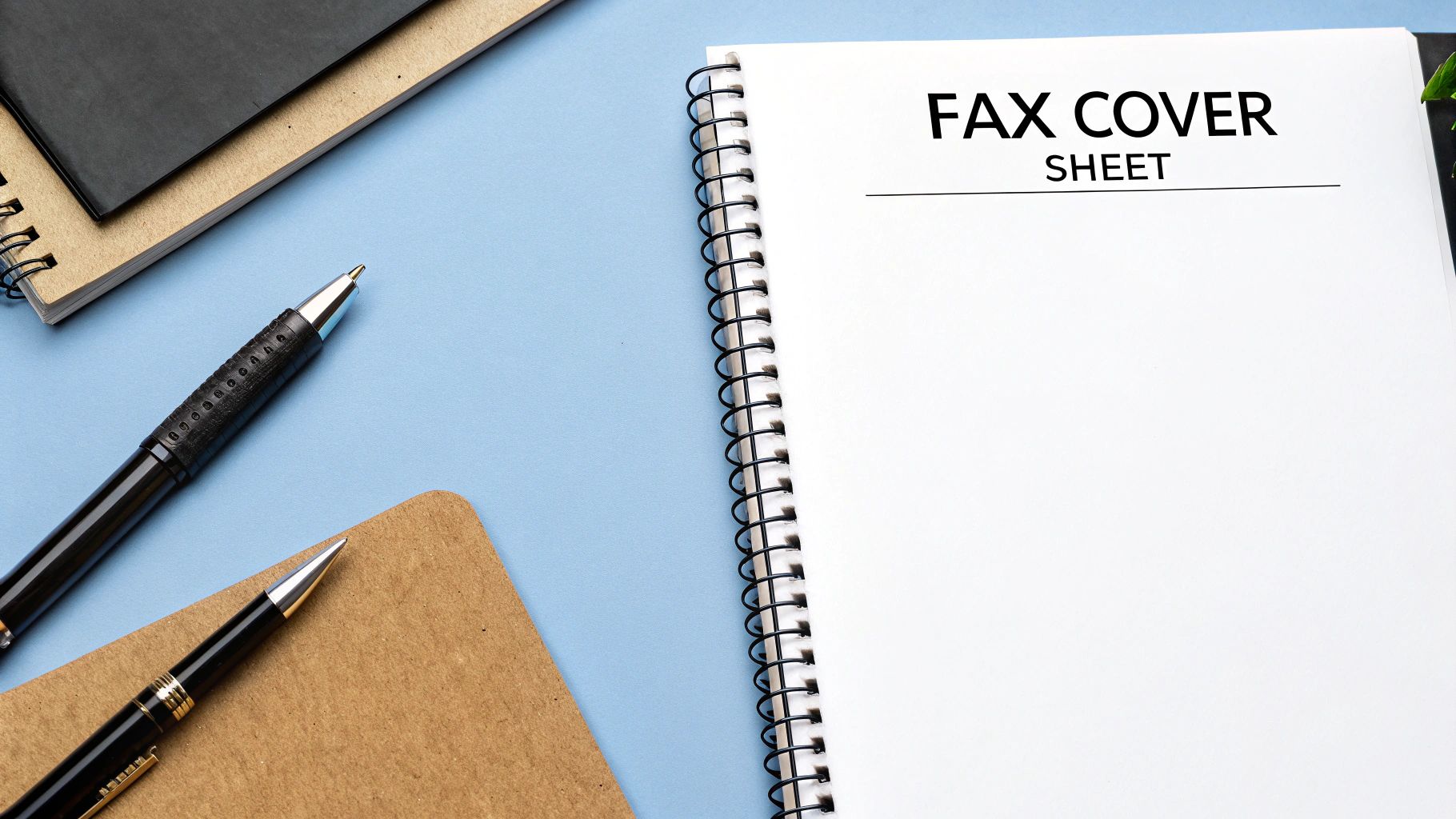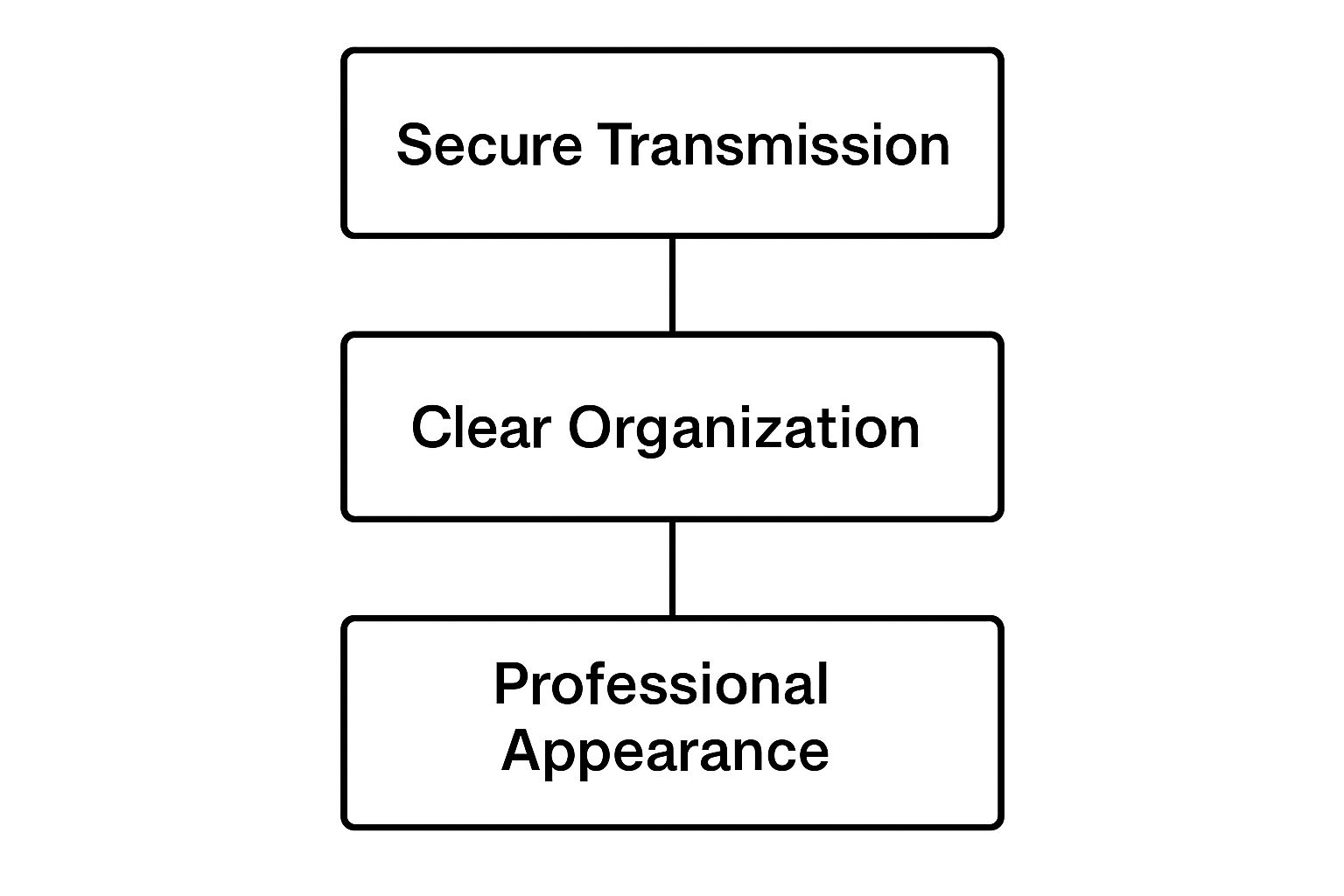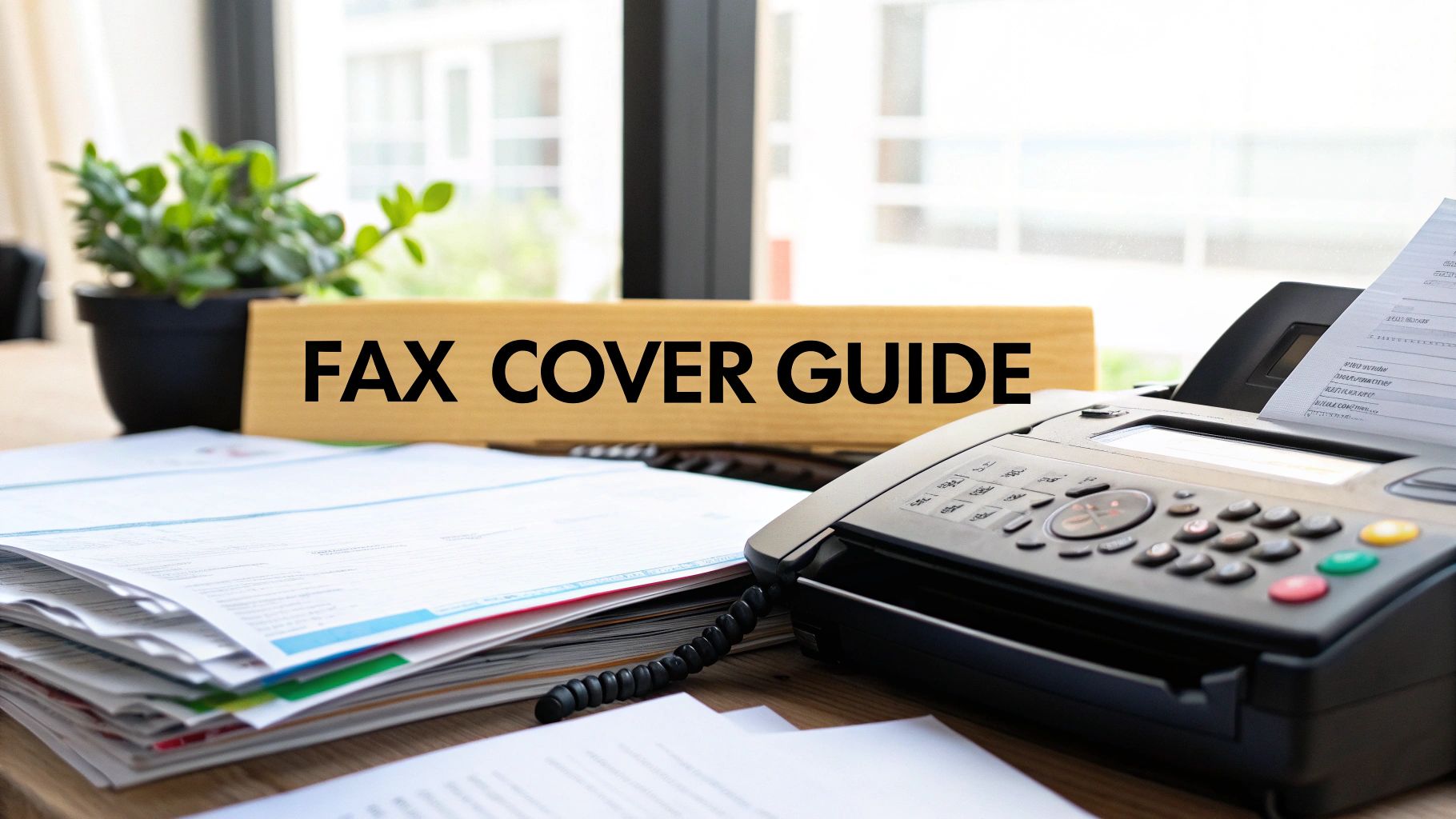A professional fax cover sheet template isn't just a formality—it's a vital tool for making sure your documents arrive securely, professionally, and in the right hands. Think of it as a friendly, professional receptionist for your faxed documents. It provides all the essential context before your recipient even lays eyes on the main message, saving time and boosting your credibility with every single fax you send.
Why a Professional Fax Cover Sheet Still Matters

Before you write off faxing as a relic from a bygone era, it's worth understanding just how important it remains in major industries. Fields like healthcare, finance, and law still lean heavily on faxing because of its rock-solid security protocols and legally recognized status. In this world, a well-designed fax cover sheet template isn't just an accessory; it's your first line of defense.
Imagine sending highly sensitive legal files or confidential patient records. Without a cover sheet, those papers could end up in a shared office printer tray, visible to anyone who walks by. A cover sheet acts like a protective wrapper, immediately signaling the document's importance and who it's for, safeguarding it from prying eyes.
The Undeniable Relevance of Faxing Today
While email and instant messaging have taken over much of our communication, faxing has carved out a permanent and surprisingly relevant niche. The truth is, fax machines are still everywhere. As recently as 2019, there were over 43 million active fax machines worldwide, sending more than 17 billion documents each year. That's not just surviving—it's thriving as a key communication tool in many sectors. You can explore more about the continued use of faxing and its impact on modern business.
A fax cover sheet does more than just introduce your document. It establishes a chain of custody, provides critical contact information for follow-up, and can include legally binding disclaimers that protect both you and the recipient.
To get a quick handle on its value, it helps to break down the core functions of a professionally structured cover sheet. Each piece has a specific job, from simple organization to crucial legal protection.
Core Functions of a Fax Cover Sheet
Here’s a quick summary of what a cover sheet actually does and why each part is so important.
| Function | Description | Importance Level |
|---|---|---|
| Recipient Identification | Clearly names the intended recipient and their department. | High |
| Sender Information | Provides your contact details for easy reply or verification. | High |
| Confidentiality Notice | Includes a legal disclaimer to protect sensitive information. | Critical |
| Document Organization | States the total page count to ensure full delivery. | Medium |
| Professional Branding | Displays your company logo and maintains a consistent image. | Medium |
This table shows how a simple page adds multiple layers of clarity and security to your communication.
More Than Just a Piece of Paper
Ultimately, using a fax cover sheet template is a smart, strategic move. It makes you look professional, tightens up security, and helps with compliance for regulations like HIPAA in healthcare.
It ensures your message isn't just received, but handled with the right level of care and urgency. By taking a moment to add this crucial first page, you head off potential mix-ups, protect sensitive data, and reinforce your reputation as a thorough, reliable professional. It’s a small step that pays off big in peace of mind and efficiency.
Anatomy of an Effective Fax Cover Sheet Template
Think of a fax cover sheet template as the receptionist for your document. It's the first thing your recipient sees, and its job is to make sure the important stuff gets to the right person, right away. A good cover sheet does more than just announce a fax’s arrival; it guides it safely, prevents mix-ups, and makes you look professional from the get-go.
Sure, you could scribble a few notes on a blank page and call it a day. But taking a moment to understand why each part of a cover sheet matters is what separates a decent fax from a great one. Let’s break down the essential pieces that make a template truly work for you.
Core Informational Components
At its heart, a fax cover sheet is all about clear, immediate context. These are the non-negotiable details that prevent your document from ending up in a black hole.
- Sender Information: This means your name, company, direct phone number, and fax number. If the transmission is fuzzy or a page goes missing, this is the recipient's lifeline to ask you for a resend. Simple, but critical.
- Recipient Information: Be specific. Include the person's full name, their department or title, and their direct fax number. This is crucial in large companies where a fax sent to a general number could sit in a mailroom tray for days.
- Date and Time: This adds an official timestamp to your document. It's especially important for anything time-sensitive, like legal filings, signed contracts, or medical records where proof of when it was sent is everything.
These three elements work together to remove any guesswork. It's a clear record of who sent what, to whom, and when.
Organizational and Structural Elements
Beyond the basics, a few other fields turn your cover sheet from a simple note into a smart organizational tool. These features help the recipient instantly check and manage what they’ve just received.
One of the most important is the page count. The best way to format this is "Page 1 of X," where X is the total number of pages including the cover sheet itself. So, if you have a cover sheet plus four pages of content, your page count should read "Page 1 of 5." This tiny detail allows the recipient to immediately see if they have the complete document. If they only count four pages, they know to call you right away.
A well-structured fax cover sheet acts as a quality control checkpoint. It gives the recipient the tools to verify the document's integrity on the spot, preventing miscommunications and ensuring all information arrives as intended.
Another key piece is the subject line or comments section. This is your chance to give immediate context. A subject like "Signed Contract for Project Phoenix" or "Urgent Patient Referral for John Smith" tells the recipient exactly what they have and how to prioritize it. It’s far more effective than a blank field.
This infographic shows how these different parts come together.

As you can see, it all starts with secure transmission. That security allows for clear organization, which ultimately creates a professional impression.
The Critical Role of a Confidentiality Disclaimer
Now for what might be the most overlooked—and most important—part of a professional fax cover sheet template: the confidentiality disclaimer. If you work in healthcare, law, finance, or any field handling sensitive information, this isn't just a good idea; it's essential.
This small block of text is a powerful legal shield. It usually states that the information in the fax is confidential, privileged, and meant only for the intended recipient. More importantly, it gives clear instructions to anyone who might receive it by mistake.
A standard disclaimer will tell an unintended recipient to:
- Avoid reading, copying, or sharing the contents.
- Immediately call the sender using the contact info provided.
- Securely destroy the document.
In healthcare, this disclaimer is a key part of staying HIPAA compliant and protecting patient information. For lawyers, it helps maintain attorney-client privilege. Leaving this out could expose you and your company to serious liability if that information ends up in the wrong hands. It’s a simple addition that adds a crucial layer of professional and legal protection.
Free Downloadable Fax Cover Sheet Templates

Knowing what goes into a good cover sheet is one thing. Actually putting it into practice without wasting time is another. To help you get a running start, we've put together a library of free, fully editable templates for just about any situation you'll encounter.
Each fax cover sheet template is designed to be clean, professional, and ready to go in seconds. Think of them as the bridge between knowing and doing. Forget wrestling with layouts from scratch—just grab the format you need, pop in your details, and send your fax with confidence. They’re available in Microsoft Word (.docx), PDF, and Google Docs formats to make things as easy as possible.
The General Business Template
This is your everyday workhorse. The General Business template is your go-to for all-purpose professional communications, whether you're sending an invoice, confirming an order, or sharing a quick project update. It's built around a clean, no-nonsense layout that puts clarity first.
We've included all the essentials without any of the fluff:
- Clear spots for sender and recipient info.
- A dedicated subject line so your recipient knows what it's about instantly.
- Space for a brief message or any special instructions.
- A page count field to make sure nothing gets lost.
Its minimalist design is what makes it so versatile. It doesn’t matter if you’re a small business owner, a freelancer, or working in a massive corporation—this template gives you a polished and reliable first impression for any non-confidential fax.
A well-chosen template does more than just organize information; it reflects the sender's attention to detail and professionalism. Using a template tailored to your purpose shows the recipient that you value both their time and the security of the information being sent.
The Medical and Legal Template
When you’re dealing with sensitive information, your responsibilities go way beyond just hitting "send." Industries like healthcare and law are bound by strict regulations like HIPAA, which dictates how Protected Health Information (PHI) must be handled. Our Medical and Legal template was built from the ground up to meet these higher standards.
The most critical piece of this template is its built-in confidentiality disclaimer. This isn't just filler text; it’s a legally-vetted statement essential for protecting patient data and maintaining attorney-client privilege. It clearly tells anyone who might receive the fax by mistake what they need to do—usually, contact the sender right away and destroy the document. If you want to dive deeper into these notices, our guide on the confidential cover sheet has all the details.
This specialized fax cover sheet template includes:
- A prominent, pre-written confidentiality notice.
- Fields for case numbers or patient IDs for quick and easy reference.
- A professional, no-frills design that communicates the serious nature of the documents.
Using this template is a non-negotiable step in demonstrating due diligence and protecting yourself from liability when faxing highly sensitive records.
The Branded and Creative Template
Your brand identity shouldn’t end with your website or email signature. For marketing agencies, sales teams, or any business that wants to make a strong visual statement, the Branded and Creative template is the perfect fit. It gives you a professional framework with extra room for your branding.
This template is designed for easy customization. You can drop in your company logo, tweak the colors to match your brand palette, and adjust the layout so the cover sheet feels like a seamless part of your marketing materials. While it still has all the necessary fields for information, its real job is to reinforce your brand identity every time you send a fax. It’s ideal for sending proposals, press releases, or creative briefs where making a memorable first impression counts just as much as the content itself.
How to Customize Your Template for a Professional Edge
A generic fax cover sheet template is a fantastic starting point, but let's be honest, true professionalism is all in the details. Customizing your template is what takes it from a simple utility to a powerful branding tool. Think of it like this: a generic template is a rented tuxedo, while a custom one is a tailored suit—it just fits better and makes a much stronger impression.
This isn't just about slapping your name on a pre-made document. It's about refining the layout so it’s easy on the eyes, weaving in your brand identity, and adding custom fields that make your day-to-day tasks easier. You’d be surprised how even small tweaks can boost your document's credibility and polish your professional image.
Injecting Your Brand Identity
The single most impactful change you can make is adding your brand's visual elements. This instantly tells the recipient who sent the fax, even before they’ve read a single word.
Start with your company logo. Pop it in the header, usually in the top-left or top-right corner. This simple action creates immediate brand recognition and gives the document a more official feel. Consistency is everything here; using the same logo and placement across all your business communications builds a cohesive brand that people remember.
Next, think about your brand colors. You don't need to turn your cover sheet into a rainbow, but subtly using a brand color in the header or for section titles can make it stand out. Just a touch of your company’s specific blue or green can make the document uniquely yours without looking unprofessional.
Refining the Layout for Clarity
A well-organized layout is your best friend. It guides the recipient's eye and makes the information incredibly easy to digest. You can improve just about any standard template with a few smart structural changes.
- Group Related Information: Keep sender and recipient details in their own separate, clearly defined blocks. This logical grouping prevents any mix-ups and makes it a breeze to find key contact info at a glance.
- Use White Space: Don't cram everything together. Leaving plenty of white space around each section makes the document feel less cluttered and much more approachable. This is a big deal for faxes, where transmission quality can sometimes make things hard to read.
- Prioritize Key Fields: Make sure the "Subject" and "Page Count" fields are prominent. Bolding these labels or giving them a bit more room ensures the recipient immediately knows what the fax is about and can check that all the pages came through.
Customization is all about creating a document that works for you. A thoughtfully modified template not only looks more professional but also streamlines your workflow by pre-populating information and standardizing how you communicate.
Adding Custom Fields for Efficiency
This is where a customized fax cover sheet template really starts to pay off by saving you precious time. Think about the information you find yourself writing over and over again on every single fax. By adding dedicated fields for this data, you create a template that’s perfectly tailored to your needs.
For example:
- Legal Firms: You could add a "Case Number" or "Client Matter ID" field.
- Medical Offices: Including a "Patient ID" or "Referring Physician" line would be a game-changer.
- Accounting Firms: A "Client ID" or "Tax Year" field would be invaluable.
Creating these custom fields means you—or anyone else on your team—can fill out the cover sheet faster and with fewer mistakes. This level of preparation shows a high degree of organization and attention to detail. For more ideas, you can explore the different kinds of printable fax cover sheet available and adapt them for your industry.
These principles of creating clear, professional documents aren't just for faxes. They apply to other formal communications, too, like crafting a compelling letter of intent for a visa application. In both scenarios, a clear, customized, and professional presentation is key to making a great impression. By investing a little time upfront to customize your template, you're creating a valuable asset that strengthens your brand and makes you more efficient with every fax you send.
Best Practices for Sending Faxes Securely

Sending a fax is about more than just feeding a document into a machine and pressing a button. To make sure your documents land safely and are handled correctly, it pays to follow a few simple best practices. This is especially true when you're dealing with sensitive or regulated information, where one little mistake can cause big problems.
Think of it like a pilot's pre-flight checklist. Before you send anything, you need to confirm all systems are go. This quick routine helps you sidestep common errors, protect confidential info, and make sure your message arrives exactly as you meant it to. It's a professional habit that adds a serious layer of security to your communications.
Your Pre-Transmission Checklist
Before your fax ever leaves the machine or your computer screen, run through these simple but critical checks. It only takes a moment, but it can save you a world of headaches down the road.
-
Double-Check the Recipient's Fax Number: A single wrong digit is the number one reason faxes end up in the wrong hands. Always, always verify the number before you hit send, especially if it's the first time you're faxing that person or company.
-
Verify the Page Count: Your fax cover sheet template should clearly state the total number of pages you're sending, including the cover sheet itself. Do a quick physical count to make sure it matches what you wrote down. This helps the person on the other end confirm they got the whole document.
-
Confirm All Pages Are Legible: Give your documents a quick once-over to ensure the text is clear and free of smudges or printing glitches. A poor-quality original can turn into an unreadable mess on the receiving end, completely defeating the purpose.
The Power of a Confidentiality Disclaimer
In fields like healthcare, finance, and law, the confidentiality disclaimer on your cover sheet isn't just a polite formality—it's a critical security measure. This small block of text is your legal notice about the sensitive nature of the information inside.
A well-crafted confidentiality disclaimer acts as a legal safeguard. It immediately informs anyone who receives the document—whether intended or by accident—of their obligations to protect the information and the potential consequences of failing to do so.
A solid disclaimer should tell an unintended recipient to stop reading, not copy or share the contents, and immediately get in touch with you. For healthcare, this is a cornerstone of HIPAA compliance, as it shows you're taking clear steps to protect patient data.
The ongoing need for secure document transmission is a big reason why faxing is still around. The global fax services market was valued at around $3.18 billion in 2022 and is projected to keep growing. This growth is powered by industries that rely on the secure transfer of documents, often using a HIPAA-compliant fax cover sheet template. You can learn more about how faxing continues to be a matter of fact in business today.
Modern Solutions and Enhanced Security
The old-school principles of secure faxing have gotten a major upgrade with new technology. Modern online fax services, like PayPerFax, have built these best practices right into their platforms, making security much more straightforward and user-friendly.
When you use an online fax service, the cover sheet is more than just an introduction; it becomes part of a secure digital workflow. These services often give you delivery confirmations, which are like a digital receipt proving your fax was successfully sent. This takes away the guesswork of traditional faxing, where you might not know if a document arrived unless someone calls you.
Services like PayPerFax also use SSL encryption to shield your documents as they travel online, adding a layer of security that old-fashioned phone lines just can't offer. Your data is scrambled and protected from the moment you click "send" until it safely arrives. It's this blend of timeless best practices and modern tech that provides a secure, efficient, and reliable way to handle your faxing needs.
Common Questions About Fax Cover Sheets
Even when you feel like you have a handle on what a fax cover sheet template is for, some practical questions always seem to pop up. It's one thing to know the theory, but it’s another to confidently put it into practice during a busy workday. This section is all about clearing up that lingering confusion.
Think of this as your quick-reference guide for the real-world side of faxing. We’ll tackle the most common questions head-on with straightforward answers, helping you send every fax professionally and securely.
Is a Fax Cover Sheet Legally Required?
This is easily one of the most common questions, and the answer isn't a simple yes or no. While there's no universal law that says you must use a cover sheet for every single fax, in a professional setting, they are practically essential.
For many industries, a cover sheet is a core part of staying compliant. Take healthcare, for example. The Health Insurance Portability and Accountability Act (HIPAA) demands that organizations take all reasonable steps to protect patient health information (PHI). A fax cover sheet, complete with a clear confidentiality notice, is a fundamental way to show you’re doing your due diligence.
The same logic applies in legal and financial fields, where cover sheets help maintain client confidentiality and attorney-client privilege. It creates a professional barrier that protects sensitive data from being accidentally seen by the wrong person.
So, while you might get away with skipping it on a casual fax to a friend, in any business context, it's a critical best practice. It's your first line of defense against compliance headaches and accidental data leaks.
What Should a Confidentiality Disclaimer Include?
That little block of text at the bottom of your cover sheet is more than just legal fluff—it’s a direct instruction manual for anyone who might get your fax by mistake. A strong disclaimer is your best tool for protecting sensitive info.
To be truly effective, your confidentiality notice needs a few key elements:
- A Clear Statement of Intent: Start by stating that the document is confidential, privileged, and meant only for the person it's addressed to.
- Instructions for Unintended Recipients: This is the most important part. Tell anyone who receives the fax by mistake that they are strictly forbidden from reading, sharing, or copying it.
- A Call to Action: Give them clear next steps. Usually, this means calling the sender right away (be sure to include your phone number) and securely destroying the fax.
Sample Confidentiality Notice: "This facsimile is intended for the sole use of the designated recipient and may contain confidential and privileged information. Any unauthorized review, use, disclosure, or distribution is prohibited. If you are not the intended recipient, please contact the sender immediately by telephone at [Your Phone Number] and destroy the original message."
Adding this language to your fax cover sheet template creates a powerful safeguard that shows you take data security seriously.
Can I Use a Digital Template with an Online Fax Service?
Absolutely! In fact, pairing a digital template with an online fax service is one of the smartest and most efficient ways to manage your faxing. Modern internet fax services are built to work perfectly with digital documents.
It usually works in one of two ways:
- Use a Built-In Generator: Most online fax platforms have their own cover sheet tools. You just type in the sender, recipient, and subject, and the service generates a clean cover sheet for you.
- Upload a Custom Template: If you want more control over your branding, you can upload your own custom fax cover sheet template as a PDF or Word file. The service will then add it as the first page of your fax.
Going digital like this has huge upsides. You can save different templates for different purposes, pre-fill recurring info to save time, and get digital delivery receipts for your records. This evolution is a big reason faxing is still so relevant.
The growth of internet and cloud faxing has completely revitalized the industry. User surveys found that over 80% of respondents said their fax usage was either growing or staying steady. The whole industry is shifting, with digital faxing expected to jump from 31% to over 70% of all fax activity soon. You can learn more about these faxing industry trends and see how they're reshaping business communication.
How Do I List the Page Count Correctly?
This is a tiny detail that often trips people up, but getting it right is crucial for avoiding confusion. The universal best practice is simple: always include the cover sheet in the total page count.
For example, if you're sending a fax with one cover sheet and four pages of actual documents, your total page count is five. On your cover sheet, you should write:
- Total Pages: 5
- Or, even better: "Page 1 of 5"
This eliminates all guesswork. When the recipient gets the fax, they can do a quick physical page count. If the number matches what's on the cover sheet, they know the transmission was a success. If the numbers don't line up, they know a page went missing and can call you for a resend. It's a simple step that makes a huge difference in ensuring accuracy.
Ready to send faxes with confidence and professionalism? PayPerFax offers a simple, secure, and subscription-free way to send faxes online. With our easy-to-use platform, you can upload your documents, use a professional cover sheet, and send your fax in minutes—all protected by SSL encryption. Stop worrying about old fax machines and start sending smarter. Try PayPerFax today for your occasional faxing needs and only pay for what you send. Visit us at https://payperfax.com to get started.



